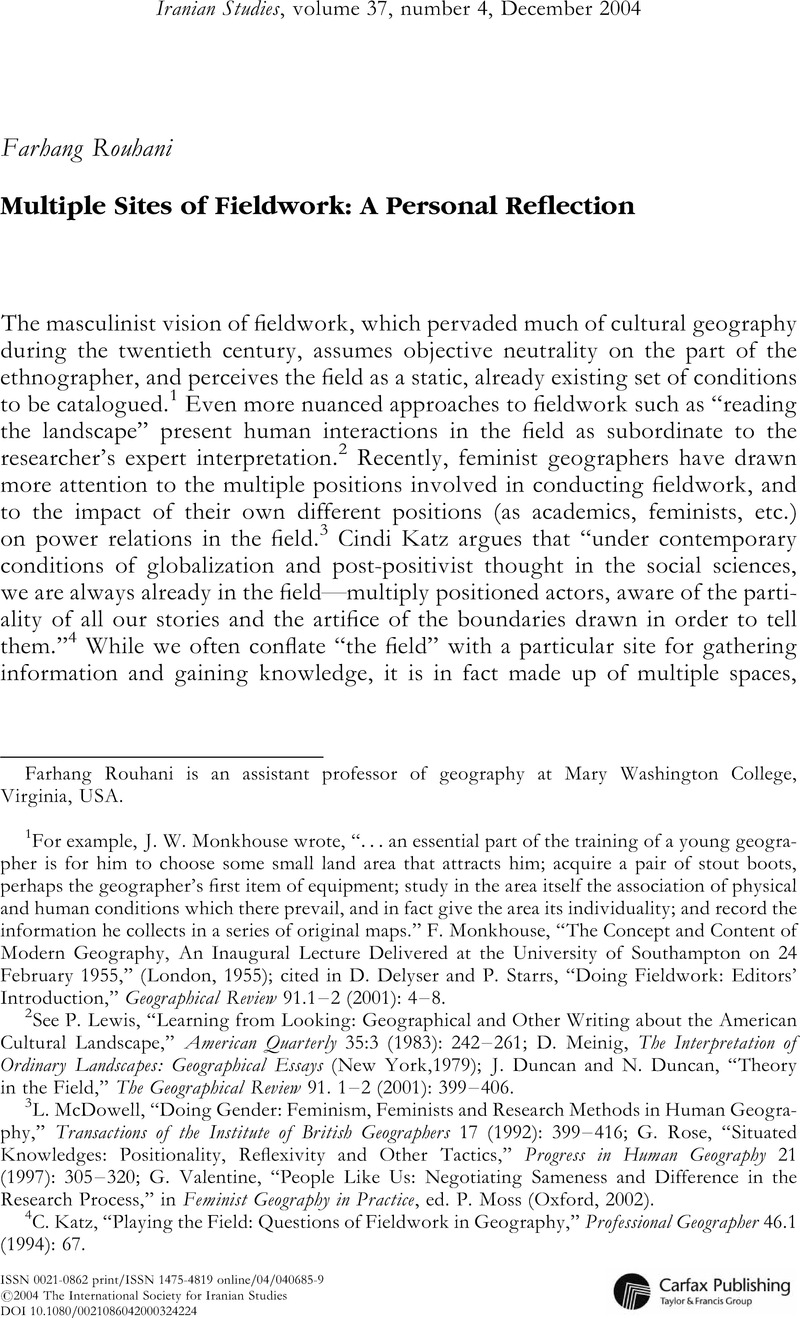Article contents
Multiple Sites of Fieldwork: A Personal Reflection
Published online by Cambridge University Press: 01 January 2022
Abstract

- Type
- Articles
- Information
- Iranian Studies , Volume 37 , Issue 4: Special Issue: Ethnographic Fieldwork in Iran , December 2004 , pp. 685 - 693
- Copyright
- Copyright © 2004 The International Society for Iranian Studies
References
1 For example, J. W. Monkhouse wrote, “… an essential part of the training of a young geographer is for him to choose some small land area that attracts him; acquire a pair of stout boots, perhaps the geographer's first item of equipment; study in the area itself the association of physical and human conditions which there prevail, and in fact give the area its individuality; and record the information he collects in a series of original maps.” Monkhouse, F., “The Concept and Content of Modern Geography, An Inaugural Lecture Delivered at the University of Southampton on 24 February 1955,” (London, 1955)Google Scholar; cited in Delyser, D. and Starrs, P., “Doing Fieldwork: Editors' Introduction,” Geographical Review 91.1–2 (2001): 4–8Google Scholar.
2 See Lewis, P., “Learning from Looking: Geographical and Other Writing about the American Cultural Landscape,” American Quarterly 35:3 (1983): 242–261CrossRefGoogle Scholar; Meinig, D., The Interpretation of Ordinary Landscapes: Geographical Essays (New York, 1979)Google Scholar; Duncan, J. and Duncan, N., “Theory in the Field,” The Geographical Review 91. 1–2 (2001): 399–406CrossRefGoogle Scholar.
3 McDowell, L., “Doing Gender: Feminism, Feminists and Research Methods in Human Geography,” Transactions of the Institute of British Geographers 17 (1992): 399–416CrossRefGoogle Scholar; Rose, G., “Situated Knowledges: Positionality, Reflexivity and Other Tactics,” Progress in Human Geography 21 (1997): 305–320CrossRefGoogle Scholar; Valentine, G., “People Like Us: Negotiating Sameness and Difference in the Research Process,” in Feminist Geography in Practice, ed. Moss, P. (Oxford, 2002)Google Scholar.
4 Katz, C., “Playing the Field: Questions of Fieldwork in Geography,” Professional Geographer 46.1 (1994): 67CrossRefGoogle Scholar.
5 Most of my observations refer to my dissertation research. I conducted it over a period of four months in 1999, using mainly a combination of interviews with young Iranian satellite television and Internet users, and participant observation of some of these young people as they were using the technologies in their homes and in cybercafes. I interviewed a total of 40 young Tehranis and conducted participant observation in five homes. Each interview lasted about an hour and consisted of semi-structured, open-ended questions. To avoid complications, I manually recorded the interviews on paper. For a full discussion of the methodology and results of this work, see: Rouhani, F., “The Home as a Site of State Formation: The Politics of Media Consumption in Tehran, Iran” (Ph.D. diss., University of Arizona, 2001)Google Scholar. Abrams, P., “Notes on the Difficulty of Studying the State,” Journal of Historical Sociology 1.1 (1988): 58–69CrossRefGoogle Scholar; Alonso, A., “The Politics of Space, Time, and Substance: State Formation, Nationalism, and Ethnicity,” Annual Review of Anthropology 23 (1994): 379–405CrossRefGoogle Scholar; Joseph, G. and Nugent, D., eds. Everyday Forms of State Formation, (Durham, 1994)Google Scholar.
6 Abu-Lughod, J., “Going Beyond Global Babble,” in Culture, Globalization, and the World-System, ed. King, A. (Minneapolis, 1997)Google Scholar.
7 Among other things I found myself busily fending off relatives trying to find me a wife. I have since learned of similar cases, which makes my experiences with matchmaking less unique than I originally thought them to be.
8 Pasdars are members of the Sepah-e Pasdaran, the Revolutionary Guards Corps created after the 1979 revolution as a security force to uphold and maintain the Islamic tenets of the revolution. Practically speaking, they are the morality police.
9 Myers, G., “Protecting Privacy in Foreign Fields,” Geographical Review 91.1–2 (2001): 199CrossRefGoogle Scholar.
10 It is important to point out, though, that within Islamic teachings, the concept of taqiyya allows for dissimulation as a strategy for self-protection and -preservation.
- 4
- Cited by


